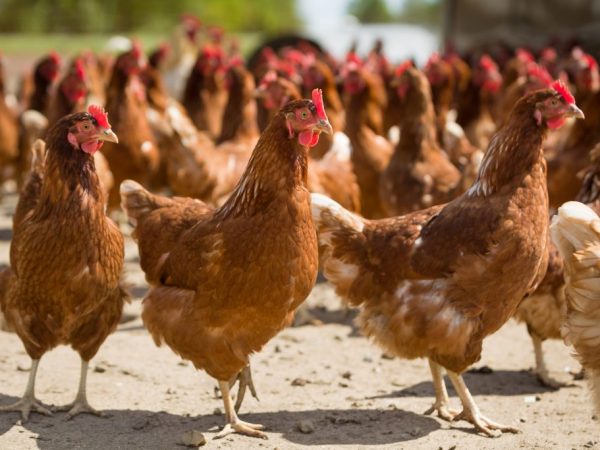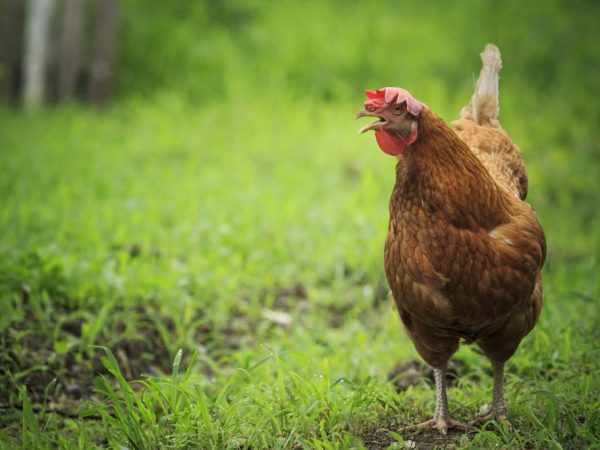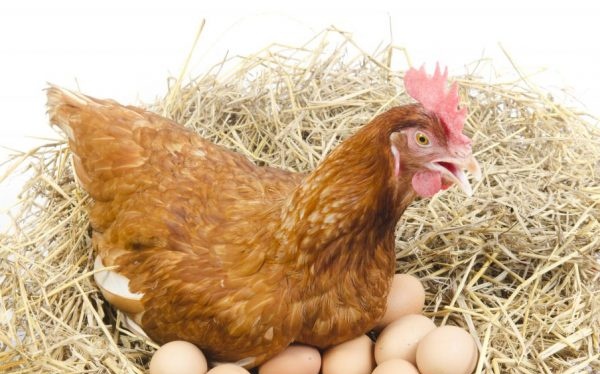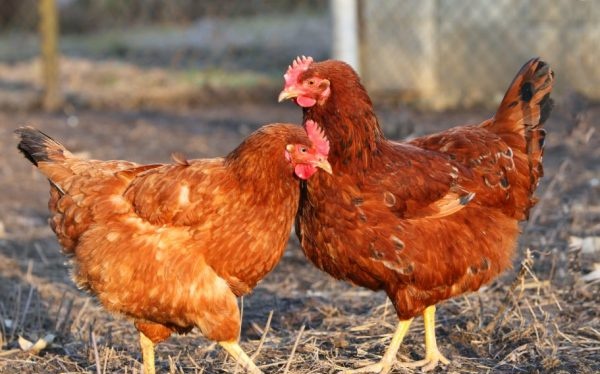Breed of chickens Brown Nick
With the development of genetics, breeders have achieved incredible success in creating new breeds of poultry. But even against their background, Brown Nick chickens stand out for their unique qualities. Although it is more correct to call this type of laying hens an egg cross, i.e. the result of intraspecific crossing.
- Brief information about the breed
- Full description
- The cost
- Appearance
- Character
- Incubation instinct
- Productivity
- Advantages and disadvantages
- Breeding features
- Incubation
- Chicks feeding
- Chick care
- Keeping adults
- What should be a chicken coop
- Food
- Place for walking
- Molting and a break in egg production
- Replacement of livestock
- Possible diseases
- Owner reviews

Breed of chickens Brown Nick
The hybrid was developed in 1965 by specialists from the German company H&N International. It is the most common egg cross in Germany and is very popular in Europe and the USA. Their official partners work in the Russian Federation, who sell hatching eggs and young Brown Nick that meet strict European standards.
Brief information about the breed
- Productivity type: egg.
- Rooster weight: medium, 2.5 kg.
- Chicken weight: 2.0 kg by 20 months.
- Ovipositor start: at the age of 21 weeks.
- Egg production: very high, more than about 400 pcs. per year for a hen aged 18 months, 250 pcs. per year - in young animals (younger than 8 months).
- Features of the: resistance to diseases, stress resistance, good survival rate of chickens (98%), low feed consumption, unpretentious care.
- Egg size: in young layers - up to 60 g, in adults - large, up to 70 g.
- Are they suitable for a beginner: Yes.
Full description
The Brown Nick hybrid is a small bird with early egg production and high productivity. They are characterized by:
- small size;
- low feed intake;
- good tolerance of cellular content;
- high immunity to the most dangerous diseases of birds.
Birds are responsive to comfortable growing conditions and tolerate vaccination well.
The eggs produced are large and taste great, without fishy odor.
European farmers consider this hybrid to be one of the most profitable chicken breeds: they give a stable profit already in the first year of life.
The cost
Daily young growth from breeding poultry farms is sold for 35-40 rubles.
Hatcheries offer 4-month-old hens for 450 rubles, chickens at the age of 1.5 months - 180 rubles.
On Avito, for a vaccinated pullet at the age of 1.5 - 4.5 months, they ask for 500 rubles. On Yulia - from 350 rubles.
Appearance
Chickens of the Brown Nick breed are autosex. This means that the chickens of this cross can be distinguished already at the age of 1-2 days:
- males are covered with uniform light yellow down;
- hens are darker, brownish-yellow in color.
The differences are gradually increasing. Roosters are distinguished by white plumage, trapezoidal body shape. The weight of an adult male is 2.5 kg;
The name of the cross was given by the color of the layers: they have a red-brown color.

Male weight reaches two and a half kilograms
Description of chickens:
- the body is small, the weight barely reaches 2 kg;
- trapezoidal body shape;
- feathers tight-fitting, shiny, brown with a white tip;
- scallop small, erect, bright red.
Character
This breed easily adapts to any conditions of keeping, and quickly gets used to the limited space of cages.
- Laying hens are calm, not shy and stress-resistant.
- Roosters are peaceful, practically do not fight and do not express negativity towards males.
This hybrid is distinguished by an even character, therefore it is recommended for breeding for beginners. Birds calmly endure restriction of movement, but when free walking is possible, they quickly become active.
Incubation instinct
Maternal instinct is lost in chickens. This is understandable: they were bred exclusively for the early and abundant production of high-quality eggs.
During puberty, laying hens bring up to 2 eggs per day. In addition, chickens from egg crosses do not inherit the productive qualities of their parents, and there is no point in breeding them.
If it is nevertheless necessary to breed offspring, an incubator method is used.
Productivity
The Brown Nick breed belongs to egg crosses with excellent egg production. They begin to rush at the age of 21-23 weeks.
Up to 8 months, young hens bring up to 250 pieces. per year (testicles of medium size, no more than 50-60 g).
From the year of life, the productivity of the laying hen increases, reaching a peak by 18 months. At this time, the chicken produces up to 400 pieces. per year, i.e. 1-2 pcs. in a day.
The eggs have an excellent taste, no fishy odor, with a bright light orange yolk. The shell is strong, uniform brown in color. The products have good keeping quality and transportability.
Advantages and disadvantages
There are several main advantages of this line.
- High productivity: up to 400 eggs per year, and egg production does not stop in hot and cold weather.
- Excellent taste of eggs.
- Longer, in comparison with other crosses, the period of high productivity - up to 2 years.
- Good health, avian disease resistance and endurance.
- Stress tolerance: layers are calm, and males are contact and not aggressive.
- High brood survival rate - 98%.
- Small amount of required feed - no more than 100 g / day.
- Large eggs (up to 70 g) with a bright yolk and strong shell, suitable for storage and transportation.
At the same time, Nick Brown is not without flaws.
- Limited period of high productivity: at 18 months old Brown Nick hens are at their peak, but after 25 months the number of eggs begins to decline.
- The inability to form offspring with the same high rates.
- Increased requirements: to the content (temperature, illumination), quality of feed, timely vaccination.
Despite the existing disadvantages, the advantages of the breed are so obvious and significant that they cover the costs of keeping.
Breeding features
Incubation

Females lay large eggs
From cross-laying hens at home, you can get quite healthy offspring, but it does not inherit the properties of the parents, therefore eggs for breeding are purchased on specialized poultry farms.
The incubation process for chicken eggs is divided into 2 stages. For this procedure, industrial or homemade incubators are used.
| Period | Terms (days) | Humidity | Temperature ° С | Turn |
| 1 | 1-18 | 50-55% | 37,5 – 37,8 | Each hour |
| 2 | 19-21 | 70-80% | 37,0 – 37,2 | Not needed |
Chick feeding
Chickens should eat small cereal porridge (semolina, barley, corn).
For young animals, special balanced compound feeds are chosen, which include vitamins and amino acids. In the first days, food should be taken every 2 hours.
After the third week - 5 times a day. After a month and a half - three times a day. Chicks must have access to water at all times.
Chick care
Chickens do not tolerate low air temperatures and drafts. The place for them should be fenced off with a light airtight partition.
Chicks need to create special conditions:
- temperature up to 35 ° C;
- illumination - in the first 3 days round-the-clock, luminous flux power 10 lux;
- humidity not less than 60%.
"Nursery" before placing the chickens is warmed up for several days:
- in the summer - a day;
- in winter - at least 3 days;
- in spring and autumn, with small drops in temperature, 1-2 days.
As soon as the chickens reach 1.5 months, they are moved to adult birds.
Maintenance of adults
Chickens of this breed rush even without the participation of a rooster. However, to ensure the calmness of the laying hens and maintain an active clutch, one cockerel is added to 10-15 females.
The leader controls the order in the flock and provides fertilized eggs for the incubator.
What should be a chicken coop
Brown Nick quickly get used to the new environment. They feel great both in cages and in outdoor maintenance.
For comfort, they need:
- temperature from 21 to 27 °. Even in winter, it should not fall below 5. However, birds are less tolerant of heat than cold;
- humidity - not higher than 70%, but not lower than 40%. In dry hot air, chickens become lethargic, rush worse;
- illumination: during the active period, daylight hours should be at least 16-18 hours a day; during rest (molting) it can be shortened to 12-14 hours, but not lower.

The coop must be regularly ventilated.
Drafts should not be allowed in the house, but stagnant air should also be avoided. It is optimal to carry out regular ventilation with forced ventilation.
Before the introduction of the livestock, all surfaces must be disinfected, holes must be repaired into which rodents can penetrate.
Sawdust is used for bedding, regularly replacing them as they become dirty.
Food
For chickens, 2 methods of feeding are practiced:
- meals on a schedule;
- constant access to feed.
The second method is used in poultry farms with intensive production. Its feature is special feeders.
Outside the cage content, chickens, in search of food, reflexively try to rake the ground, scattering food at the same time. To prevent this, feeders of a special design are made:
- bunker devices, their advantage is a large supply of feed;
- tray - well suited for chickens.
Eating on a schedule takes time and attention.
In winter, chickens are fed 3 times a day, in summer 4-5 times at intervals of 3-4 hours.
The basis of the bird's diet is grain. These can be a wide variety of cereals or products of their processing, for example, bran.
But along with this, for a balanced diet of chickens, their diet should contain proteins, minerals and vitamins. This is achieved through the use of animal products.
Calcium and phosphorus are required for the formation of eggshells. Their sources are chalk, shells and bone meal. Another currently common stimulant is egg production supplements. It should be remembered that industrial compound feed for laying hens already contains a balanced complex of all products.
Place for walking
Drafts and strong winds are contraindicated for chickens. Therefore, the places for walking are equipped on the leeward side of the house, but not in the shady side - the birds need lighting to prevent rickets.
The walking space is fenced with a netting netting with a height of at least 2 m. The area depends on the number of chickens and on the capabilities of their owner.
You need to place a convenient feeder in the pen. Additionally, fine gravel needs to be added there, as well as a mash or compound feed, or something else.
It is important to closely monitor the condition of the feed, because in the open air it quickly deteriorates.
Molting and a break in egg production
The molt period is a test for the bird's body. Egg production at this time decreases until it stops completely.
It can start for several reasons:
- stress;
- illness;
- parasitic insects;
- changing seasons and preparing the bird for the appropriate air temperature.

The breed is highly immune to disease
Brian Nick prince are stress-resistant, they have a high immunity to diseases, and regular treatments protect them from parasites. Therefore, they mainly have a seasonal molt.
On average, an adult hen will molt for 8-10 weeks.Sometimes the process is delayed up to 13-14 weeks, but it can be reduced to 5.
To shorten this period, a zootechnical type of molt is used, which causes short-term stress in the bird, a short cessation of egg production, but a quick change of feathers.
It is based on the use of special conditions: at first, for 4 days they do not feed, do not drink and keep in the dark. Then they start feeding small portions of foods high in protein and fiber, increasing the amount of green grass, beets, squash or pumpkin.
The water regime is restored and the illumination is gradually brought to 14-16 hours a day.
After artificial molting, chickens lay more eggs than after natural molting. The body of layers becomes more resistant to viral and infectious diseases.
Replacement of livestock
The crosses do not have a long period of productivity. After 2.5 - 3 years, egg production decreases to 30-70% of the maximum, so the livestock must be renewed.
3-4 lines took part in the creation of these birds, so if they are multiplied "in themselves", then stratification into the original breeds will go.
It is impossible to breed crosses with the same qualities as the parents from the eggs laid by hens in ordinary subsidiary plots. This is done by specialists at poultry farms.
To renew the family, they purchase eggs, chickens or pullets, specializing in the creation of crosses.
Possible diseases
Brown Nick - crosses are very hardy, like all hybrids. The survival rate is:
- 98% in chickens;
- 95 in adult birds.
However, such high rates are possible with proper care and timely vaccination. Vaccinations begin at 2-3 weeks of age and end at 17-18 weeks.
Birds suffer from an inadequate or unbalanced diet.
They react to this:
- symptoms of vitamin deficiency;
- diseases of the oviduct;
- rickets.
The livestock is affected by avian flu if an outbreak of this dangerous disease is noted in the region. Although, in contrast to 100% lesions of "pure breeds", crosses get sick in 60-70% of cases.
To prevent such a formidable disease, it is necessary:
- add vitamins, premixes to food throughout the year;
- to carry out at least 2 times a year general cleaning with disinfection of parasites, which are carriers of diseases.
Owner reviews
According to the description of the breeders, Brown Nick chickens have excellent productivity, they produce eggs even at -20 ° frost in the yard. Chicks with high survival rate: when hatching from eggs, losses are practically zero.
Owners note low feed consumption - only 100 g per head, even with intensive egg production. But the food should be balanced and high in calories.
The owners do not like the limited production period and the need to renew the livestock every 2 years.
But they call the undeniable advantage of the hybrid the taste and large size of the eggs, as well as the possibility of their transportation and long-term storage.
All Brown Nick owners consider this breed a profitable egg cross and plan to continue growing them in their backyard.


